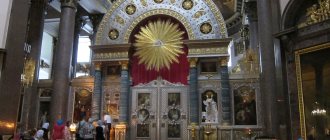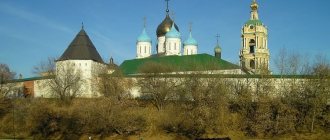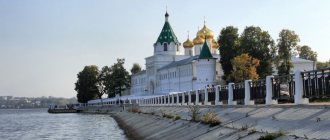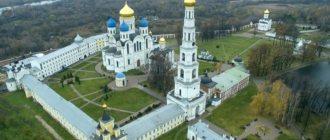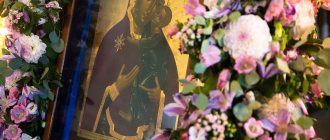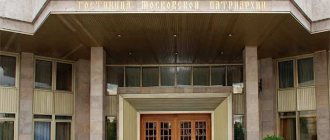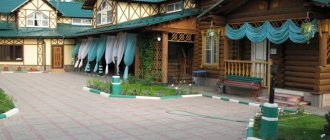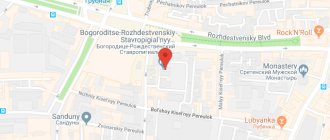In the very center of Tambov there are several magnificently beautiful churches and monasteries. For a long time they were in a deplorable state, however, restoration work in recent years has returned the Orthodox monasteries to their former attractiveness. It is now difficult not to notice the slender bell towers and domes shimmering in the sun rising above the city. In this article we will talk about the Transfiguration Cathedral, the Kazan Monastery, the Ascension Convent and some other churches in Tambov.
Historical events
Among the archival documents there is a petition from Elder Joseph to Tsar Alexei Mikhailovich, dated 1666, where he asks permission to found a monastery on the outskirts of Tambov, where a small wooden church was recently erected in honor of the appearance of the Kazan Icon of the Mother of God.
Money for construction was collected by “worldly alms.” A few years later, the new Tambov monastery was allocated a plot of land on the banks of the Tsna River, a mill and courtyards for farming. The official year of its creation is considered to be 1670, the founder is Elder Joseph.
Experts do not undertake to describe the original appearance of the monastery: it burned down in fires several times, was rebuilt many times, and most of the chronicle documents were lost.
Only by the beginning of the 19th century the complex acquired the appearance that modern reenactors recreated at the end of the 20th century. The monastery, where several monks lived, was not rich, but paid great attention to communication with parishioners. Changes in her life came in 1758, when Bishop Pachomius, who received the Tambov See, decided to settle in the monastery.
From that event until its closure after the revolution, the monastery was the bishop's residence, where objects corresponding to its status were soon built:
- house of the archpastor;
- premises for its employees;
- a bell tower, for which bells were cast according to a special order (the bishop was known as an expert in bell music); The top of the belfry was decorated with a clock that chimed the time.
All buildings were repaired and painted, and two orchards appeared in the vicinity of the monastery. The territory took on an elegant, well-groomed appearance. New orders also appeared: according to the decision of Bishop Pachomius, a procession of the cross began to take place every year on the bright week of Easter on Tuesdays and Thursdays, which turned into a good tradition. It was religiously observed until 1918.
After the great fire that happened in Tambov in 1794, Bishop Theophilus (Raev), who replaced Bishop Pachomius, decided to replace the surviving wooden buildings with stone ones.
Then two churches, Kazansky and Predtechensky, were erected, which have survived to this day, as well as a bell tower, which was destroyed in the 20th century. His Eminence Theophilus also built residential buildings for monks, an administration building, and utility buildings out of brick and surrounded it all with a stone fence. This is how the architectural ensemble of the Kazan Monastery was created.
At the beginning of the 20th century, the monastery, as a center of education for the diocese, contributed to the education of the residents of Tambov. She had her own printing house, where she published educational literature. Through her efforts, the first bookstore appeared in the city.
The names of many great figures of the Russian Orthodox Church are associated with the history of the monastery. On the territory of the monastery there was the main city necropolis, where eminent citizens were buried.
The Kazan Monastery in Tambov was closed after the revolutionary events in the country, the monks were expelled, the necropolis was destroyed, and the local branch of the Cheka was located in the vacated buildings. In the monastery basements, prison dungeons, torture chambers were created, and executions were carried out.
Ten years later, an orphanage, a convoy team and an archive moved into the renovated buildings. Later, a school for working youth appeared here. The spire was dismantled from the bell tower, which already stood without bells, and then the structure itself was dismantled to the ground.
However, its foundation was useful for the construction of a railway school on this site, and the bricks and tombstones of the cemetery were used for the construction of its walls. The territory of the monastery was redeveloped several times, city institutions rebuilt churches and other buildings to suit their needs, and then abandoned them.
By the end of the 20th century, the monastery courtyard, together with the necropolis, turned into a wasteland overgrown with nettles. In the 1990s, the dilapidated buildings of two churches and the bishop's house were returned to the church.
A temporary fence was erected around the territory, the Church of the Baptist (as the best preserved one) was repaired, a plywood iconostasis was made and consecrated. Services have resumed here. Thus began the revival of the Kazan Monastery. Restoration work in the Kazan Cathedral continued until 2007.
After its consecration, the question arose about the construction of a bell tower as the dominant feature of the monastery complex. This issue was resolved through the joint efforts of the diocesan clergy and city authorities. On the foundation of the old bell tower stood the city secondary school, where 600 children studied.
It was not easy to find a new location due to the threat of disruption to the architectural composition: the bell tower was either lost among the tall buildings approaching the monastery, or violated the landscaping area near the city monument to Komsomol member Z. Kosmodemyanskaya, or ended up in a ruined necropolis.
As a result of joint work, a compromise decision was made: to build a belfry in the free, western sector of the monastery, almost doubling its size in order to fit its height into the urban space. Construction work, installation of bells and landscaping of the adjacent area were completed in 2014.
Kazan Monastery, Tambov
The time has come for the reconstruction of the Church of St. John the Baptist, which, while fulfilling its main function, has not yet been closed for major repairs. Work continued from 2008 to 2011, after which the temple took on its historical appearance with a five-domed structure on top.
The design of the internal area of the monastery was based on its zoning. A young orchard, a park with conifers and ornamental shrubs, paved paths, and an area for religious processions appeared here, which made it possible to resume the old tradition.
Since 1992, the monastery has had a Sunday school with children's (from 4 to 16 years old) and adult groups. Classes are taught by highly qualified teachers on Sundays from 10 to 12 hours. Recruitment is made all year round. In addition to the basics of Orthodoxy, history and the lives of the Saints, music, choral singing, and home economics are taught here.
Spaso-Preobrazhensky Cathedral in Tambov
The Transfiguration Cathedral is the oldest temple in Tambov, founded in 1694 by the first Tambov bishop St. Pitirim. Before it, two wooden predecessors were laid in the same place, in 1636 and 1683, but only the third, a stone one, was completed, which has survived to this day.
During the years of Soviet power, the Tambov Museum of Local History was located in the cathedral, and a planetarium was located in the main dome. A similar fate befell many Russian churches. In 1992, the Transfiguration Cathedral was returned to the Church.
Until the 19th century, there was a wooden bell tower next to the cathedral. In 1812, the bell tower was rebuilt into a stone one, as the wooden one became too dilapidated. In 1930, by decree of the Soviet government, the bell tower was dismantled. The new bell tower was built quite recently, in 2011. Without a doubt, it is the dominant feature of Cathedral Square and the entire architectural ensemble.
To the right of the cathedral there is a monument to the Bishop of Tambov - St. Pitirim. The monument was erected in 2014 to mark the 100th anniversary of the canonization of St. Pitirim.
The territory of the Transfiguration Cathedral extends almost to the banks of the Tsna River, where the chapel and source of St. Pitirim are located. It's not clear what the power line is doing here. Perhaps it was built earlier than the territory was improved and united.
At the beginning of the 20th century, Emperor Nicholas II visited Tambov and the Transfiguration Cathedral, and also took direct part in the canonization of St. Pitirim of Tambov. It was along this alley that in 1914 the emperor walked from the cathedral to the Pitirimovsky spring, where he drank water. Since 2016, the path to the source has been decorated with a bronze bust of Emperor Nicholas II, canonized.
The first water-blessed chapel over the source of St. Pitirim was built in 1914 with a donation from Empress Maria Feodorovna, the widow of the Russian Emperor Alexander III and mother of Nicholas II. During Soviet times, the chapel was dismantled and the source was filled up. After some time, the source again made its way to the surface. Since 2007, the holy water chapel has once again risen above the Pitirimov spring, attracting everyone’s attention.
External and internal view, shrines
After its revival, the Kazan Monastery in Tambov again became not only the spiritual center of the region, this magnificent monument in the city center is its decoration and pride.
The baroque style of the ensemble with its exquisite beauty, supported by modern technical means of design (illumination of buildings, paving of paths and squares with colored tiles, use of the latest materials) attracts not only pilgrims, but also inquisitive tourists to the Tambov monastery.
Temple of the Kazan Icon of the Mother of God
The Summer Cathedral Church in honor of the Kazan Icon of the Mother of God - the main temple of the monastery after reconstruction regained its former five-domed structure, its small domes were covered with gold stars on a blue background, and the central dome was covered with gilding.
The platbands, cornices and other decorative elements are painted snow-white, while the façade itself has become soft blue. “Theotokos” and white colors give the temple an elegant and solemn appearance. In the dark, the building is illuminated from all sides, decorating not only the monastery territory, but also the city.
Restorers managed to restore the unique painting of the temple in the grisaille style. Using a rare technique for the mid-19th century, the slopes of walls, the surfaces of arches, architectural elements were painted, and scenes on biblical themes were made. Craftsmen worked on the construction of a wooden, carved iconostasis, who took the cathedral iconostasis of the Moscow St. Nicholas Monastery as a basis.
Church of John the Baptist
The Church of John the Baptist, built in 1794-1821, expanded in area and was built in height in 1876. It was reconstructed at the beginning of the 21st century and has now acquired its historical appearance.
The cult building in the eclectic style is built on the principle of a quadrangle with a traditional five-domed structure. The altar is adjacent to the main building on the east, and the refectory is on the opposite side.
The facade, plastered and painted in red, “martyr” color, is decorated with decorative elements of diverse styles, which is inherent in eclecticism; its architectural details are painted in contrasting white. The new iconostasis made of wood, covered with gilding, was made by Mordovian master carvers from the village of Zubova Polyana.
Bell tower
The former gate bell tower was the main entrance to the monastery, symbolizing the solemn entrance into the world of spirituality and purity. The new bell tower faced the same tasks, which complicated the search for a place for its construction. The location was determined, and her project, created by Tambov architects, proposed a solution that suited everyone.
A modern, slender belfry soars above the city, doubling the height of the old bell tower and surpassing it in beauty many times over.
Its height with a cross is 103.1 m, the weight of the spire with a gilded cross is slightly less than 4 tons. The structure assembled on the ground was hoisted up using a helicopter. At night, at the request of the aviators, ruby lamps light up on it, which makes the bell tower visible from anywhere in the city.
Another decoration of the Tambov bell tower is the chiming clock: they were a feature of the old bell tower, and they were installed in the new one.
On four sides of the belfry there are dials with a diameter of 4.5 m with different numbers:
- from the west - Latin;
- from the east - Greek;
- from the south - Arabic;
- from the north - Slavic.
The bells for the new bell tower were cast by Voronezh craftsmen; there are 14 of them at the top. The smallest weighs only 10 kg, and the largest weighs 1.85 tons. Upon completion of construction, a new main entrance to the monastery territory appeared - through the through gate of the bell tower. For this purpose, the internal area of the monastery was redesigned.
Theological Seminary
The Tambov Seminary resumed its work, located in the former episcopal house, where a major renovation was carried out. In 2012, the school building was given to the monastery by decision of the city authorities. After reconstruction, with the usable area more than doubling, it became one of the seminary buildings.
Within these walls, several assembly halls of different sizes, library rooms, study rooms, living rooms, a kitchen with a refectory, a sports complex, recreation rooms and utility rooms were equipped. The third monastery church of St. Cyril and Methodius is a brownie and is located in the seminary building.
Chapels and hermitages
Until 2022, there were two chapels on the monastery square. The first was erected on the site of an unpreserved monastic necropolis in memory of the townspeople buried here. The chapel was dismantled during the construction of a new seminary building.
The second appeared exactly 10 years later at the burial site of Archbishop Eugene, who made a great contribution to the restoration of the Kazan monastery. In the village of Vorontsovka, Tambov region, there is a monastery belonging to the Kazan monastery. There is a small Nicholas Church and a monastery farmstead here.
Ascension Convent in Tambov
At the intersection of Moskovskaya and Boris Vasilyevich streets, the Ascension Convent is located. It was founded in 1690 and was located at that time on the outskirts of Tambov. It seems that even now not every tourist knows the way here, which is why the territory inside the monastery looks somewhat deserted. View of the monastery from Stepan Razin Street from the bridge over the Studenets River. The entrance to the monastery is on the left. In the foreground is the former building for elderly nuns, built in 1891.
The same place at the beginning of the 20th century.
During the fire of 1724, all the chronicles about the founding of the monastery were burned. The monastery was revived only in 1744, at which time the monastery wall was erected.
The construction of a brick tower with an angel is being completed.
The monastery was built very slowly. At first, there were only 18 wooden cells on its territory; it did not even have its own temple. The first stone church of the monastery in the name of the Ascension of the Lord was founded in 1791 in the southern part of the monastery. In 1907, two side chapels were added to the temple. Now the Ascension Cathedral is the colorful dominant feature of the monastery and can be seen far beyond its borders.
Construction of the second temple began in 1816 - the Church of the Icon of the Sorrowful Mother of God.
The green building on the left is the nursing building.
Cell building.
In 1868, a shelter for orphan girls, the Olga School, was opened at the monastery. Reports on the activities of parochial schools for 1914 noted that St. Olga's school was one of the best in the diocese. In 1912, a two-story refectory was built. There were workshops in the monastery - here they wove homespun fabrics and canvases, inked cloth for robes and cassocks, made bishop's miters, and embroidered with beads, gold and silver. The sisters looked after the orchard and bee yard. During the temple festival, a five-day Ascension Fair took place near the walls of the monastery. After the revolution of 1918, the Ascension Church was closed and transferred to the city council “for use for cultural and educational purposes”, the bells were removed from the bell tower, and the Church of Sorrow was transferred to the jurisdiction of the district archive.
The second revival of the monastery began in 1988. After the restoration of the temples, a Sunday school, a water-sanctuary chapel, a cell building, a bakery and a monastery shop were built.
Interesting facts and legends
The Kazan Cathedral was once built by the novice of the Sarov Hermitage, Nathanael. Experts claim that he created a copy of the Assumption Cathedral of his monastery, which, unfortunately, has not survived; it was destroyed in the 20th century. But people were left with the cathedral in Tambov.
The Kazan Cathedral is connected with Sarov through one more name: it was here that the great ascetic of the Russian Church Seraphim of Sarov received the rank of hieromonk.
The Kazan Monastery in Tambov became the seat of episcopal authority by decision of Bishop Pachomius in 1758. This event was facilitated by the following: the Tambov diocese was abolished by decree of Emperor Peter I in 1701 and resumed more than 50 years later.
During this time, the bishop's courtyard, which was located near the city cathedral, was occupied by city services. The bishop, who received the Tambov See, decided not to argue with the city authorities, left the old buildings and began to create a court in the new territory, choosing the Kazan Monastery for this.
In 1918, the monastery was closed because the monks were accused of participating in a counter-revolutionary rebellion. This was not the last popular performance on Tambov soil that touched the monastery walls.
In 1920-1921, a peasant uprising broke out here, led by Alexander Antonov. The riot was suppressed with incredible cruelty; chemical weapons were used against the rebels. The monastery territory became a camp for participants in the uprising; torture of those arrested and executions of convicts were carried out in its basements.
Church of the Intercession of the Blessed Virgin Mary
In the eastern part of the embankment near Kronstadt Square, hidden among the trees is the Church of the Intercession, a monument of history and architecture. In the description of Tambov in 1658, it was noted that in the Pokrovskaya Sloboda, located south of the Tambov fortress, there are two churches: the Intercession of the Virgin Mary and the Great Martyr Praskovya. During a fire in 1760, the wooden building was completely destroyed; in its place in 1763, construction began on a new stone two-story church. In 1843, the design of the new Church of the Intercession was approved, construction of which began in 1844. During construction, the temple collapsed, as the pillars supporting the vaults and the main dome were seriously damaged. To make construction easier, they decided to make a wooden dome instead of a stone one. In 1869, the church was completed, and the question immediately arose about the fate of the old church building. In 1870, diocesan architects examined the old Church of the Intercession and gave a conclusion: it is one of the most ancient buildings in Tambov and must be maintained and remain in this form forever.
Unfortunately, the new church building has not survived to this day, and in the old church from 1938 to 1943. there was a dormitory and a storage room. Only old photographs have survived, depicting how the two churches of the Intercession stood side by side.
In 1944, Archbishop and surgeon Luka arrived in Tambov and began holding services. Now the Church of the Intercession of the Blessed Virgin Mary is the only surviving monument of Russian architecture from the mid-18th century in the city.
Opening hours and schedule of services
Divine services in the Church of John the Baptist are held all year round. The schedule is posted on the monastery website and at the entrance to the temple.
As a rule, services are held at the following hours:
| Weekdays | Time, service | Saturday | Time, service | Holidays (Sunday) | Time, service |
| 6-30 Matins | 7-00 Confession | 6-50 Confession | |||
| 16-00 Memorial service | 7-10 Late Liturgy | 7-00 Early Liturgy | |||
| 16-30 Great Compline. Matins | 16-15 Memorial service | 8-50 Confession | |||
| 17-00 All-night vigil | 9-00 Late Liturgy | ||||
| 16-15 Memorial service | |||||
| 16-50 Vespers (Passion) |
Description
The main cathedral of the monastery is the Church of the Kazan Icon of the Mother of God. Its foundation was laid in 1791, and the fully built temple was consecrated already in 1796. For the church project, the Assumption Cathedral from the Sarov Monastery was taken for consideration. It was here, according to legend, that Seraphim of Sarov was ordained to serve as hieromonk. And in 1811, the building became the last refuge of Bishop Theophilus, who consecrated the temple.
Cathedral of the Kazan Icon of the Mother of God
A complete restoration of the building was carried out in 2007, the great consecration after which was timed to coincide with the 325th anniversary of the Tambov diocese. Today the Kazan Cathedral has 3 tiers and high domes with crosses on them. The cathedral is decorated in blue and white tones and looks extremely elegant. The roof and all metal parts of the temple are covered with bright blue paint, with the exception of the main dome - it is decorated with gold leaf and rises like a bright onion above the temple. The blue domes are covered with golden stars.
Another temple on the territory bears the name of the Church of John the Baptist. Its foundation was laid in 1794, but construction took an incredibly long time and full consecration took place in 1821. During its existence, the temple was repaired several times, but complete restoration was carried out only in 2010. It was then that the five-domed church was recreated, and it was painted red, which today has become the hallmark of the entire monastery.
On a note! The church is a winter church because it has heating and services can be held in the cold season.
In addition to these two majestic churches, on the territory of the Kazan monastery there is also a seminary home church in honor of Cyril and Methodius, as well as two chapels:
- The chapel is a monument to those killed during the Civil War.
- The chapel as a monument to Archbishop Eugene (Zhdana).
The bell tower of the Kazan Monastery, which was rebuilt in 2009 after complete destruction in 1930, also deserves attention.
How to get there by car, public transport
Tambov is a large administrative, economic and cultural center of the region with a population of about 300 thousand people and a well-developed infrastructure. There is an airport, a railway station and a bus station; federal (P22, M4, M5) and regional highways pass near the city.
The monastery, located on the central street of Tambov, can be reached by buses and trolleybuses coming from different parts of the city (more than 20 numbers). The closest stop to the monastery is the Institute named after. Rachmaninov."
Where to stay
The Kazan Monastery is located very well in relation to transport hubs, hotels and retail outlets. Guests of Tambov have the opportunity to choose a hotel to stay that suits their tastes and financial capabilities. There are numerous hotels and hostels in the historical center of the city.
Hotel "Pharaoh"
The hotel in the city center is located at: Brigadny proezd, 3g. Modern, cozy rooms, decorated in the same style, beds with orthopedic mattresses, hypoallergenic bed linen demonstrate the administration’s concern for the comfort of guests.
All rooms contain sets of necessary furniture and household appliances. The hotel has a bar where breakfast is served every morning, and food can be ordered to your room. The hotel has a sauna, internet and parking. Room cost – 3200-4300 rubles.
Hotel "Derzhavinskaya"
One of the most popular hotels among tourists is located in the center of Tambov, within walking distance of the monastery and the main city attractions. His address: L. Tolstoy Square, 4.
The room stock is presented in categories from “Economy option” to “Apartments”. All rooms ranging from 11 to 80 m2 have private bathrooms with a set of towels and hygiene items, furnished space with sleeping places, a work area, and a living area.
The rooms are equipped with LCD TVs with satellite channels; more expensive rooms have air conditioning. The hotel has free internet, parking, business and cafe "Favorite". There is a playroom for children and babysitting services are provided. Room rates range from 1950 to 5400 rubles.
Hostel "Platon"
Hostel on Pyatnitskaya, 5 offers private rooms and beds in multi-bed rooms. The rooms for 3-6 persons have bunk beds, bedside tables, and sets of towels. Toilet and shower rooms are located on the floor.
1-2 bed private rooms have their own bathroom and necessary furniture. The hostel has a shared kitchen with necessary utensils. Cost of living – from 500 to 1400 rubles.
The Kazan Monastery, which significantly increased its territory after annexing all the lands and buildings that previously belonged to it, is surrounded by a new forged metal fence. The next stage of restoration of the historical monument in Tambov is the construction of a historical stone wall with towers.
Activities of the parish
Today the Kazan monastery is active and not only monks, but also students of the Tambov Theological Seminary live on its territory. The monastery also runs a Sunday school for children, as well as for adults who want to become part of the church.
Divine service in the Church of St. John the Baptist of the Kazan Monastery
Pilgrims come to Tambov to visit the monastery on a tour or to visit holy places. They can take part in services that take place according to the schedule:
- From Monday to Saturday at 7 a.m. Divine Liturgy, prayer service and funeral lithium. At 16.15 there is a funeral service and at 16.50 evening service and matins.
- During Saturday holidays, an all-night vigil is held at 17.00.
- During Sunday holidays, the Divine Liturgy takes place at 7.30 am.
Special festive services are held here during the first throne holidays - days of remembrance:
- Icons of the Mother of God “Kazan” - July 21 and November 4;
- Nicholas the Wonderworker - May 22 and December 19;
- John the Baptist - September 11;
- Cyril and Methodius - May 24.
The founder Joseph, Saint Nicholas, as well as the brothers Cyril and Methodius along with John the Baptist are considered the holy ascetics of the monastery.
